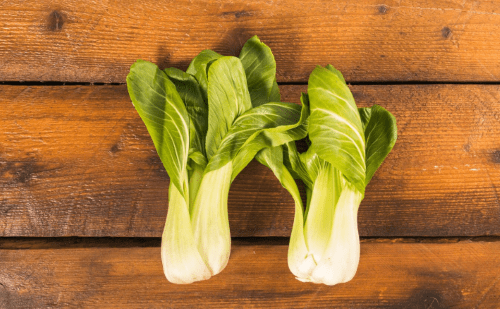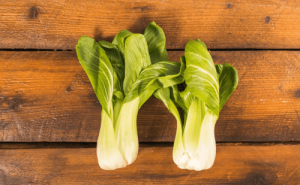Pak choi, also known as bok choy, is a versatile and nutritious leafy green vegetable popular in Asian cuisine. It’s crisp texture and mild flavor make it a great addition to various dishes. This guide covers the nutritional profile, health benefits, culinary uses, and frequently asked questions about pak choi.

1. Nutritional Profile of Pak Choi
Pak choi is a nutrient-dense vegetable that provides a range of vitamins, minerals, and antioxidants. Here’s a detailed breakdown of its nutritional content:
- Low in Calories: Pak choi is low in calories, with approximately 13 calories per 100 grams. This makes it an excellent choice for those looking to manage their weight or seeking a light, nutritious option.
- Vitamins:
- Vitamin A: Pak choi is rich in vitamin A, primarily in the form of beta-carotene. Vitamin A supports healthy vision, immune function, and skin health.
- Vitamin C: It provides vitamin C, an antioxidant that helps protect cells from damage, supports the immune system, and aids in the absorption of iron from plant-based foods.
- Vitamin K: Pak choi is high in vitamin K, which is crucial for proper blood clotting and bone health.
- Vitamin B6: It contains vitamin B6, which supports brain health, metabolism, and the production of neurotransmitters.
- Minerals:
- Calcium: Pak choi provides calcium, essential for maintaining strong bones and teeth, as well as muscle function and nerve signaling.
- Iron: It contains iron, necessary for the production of hemoglobin and the transport of oxygen throughout the body.
- Magnesium: Pak choi includes magnesium, which supports muscle and nerve function, blood sugar control, and bone health.
- Potassium: It offers potassium, which helps regulate fluid balance, muscle contractions, and nerve signals.
- Antioxidants:
- Flavonoids: Pak choi contains flavonoids with antioxidant properties that help reduce oxidative stress and inflammation.
- Glucosinolates: These compounds have been linked to a lower risk of certain cancers and may support detoxification processes in the body.
- Fiber: Pak choi is a good source of dietary fiber, which aids in digestion, helps maintain regular bowel movements, and contributes to overall gut health.
2. Health Benefits of Pak Choi
Pak choi offers numerous health benefits due to its rich nutritional profile and bioactive compounds. Here are some key advantages:
a. Supports Digestive Health
Pak choi is rich in dietary fibre, which helps promote regular bowel movements and prevents constipation. Dietary fiber also supports the health of the gut microbiome, which is important for digestive health in general.
b. Promotes Eye Health
The vitamin A and antioxidants in pak choi contribute to maintaining eye health. Vitamin A supports good vision, while antioxidants help protect the eyes from oxidative damage.
c. Enhances Skin Health
Pak choi is one source of the vital vitamins A and C in preserving healthy-looking skin. The vitamins A facilitate cell production as well as healing, while vitamins C encourage synthesis for collagen while providing protection of free radical damage towards skin.
d. Supports Bone Health
The vitamin K and calcium content in pak choi support bone health. Vitamin K aids in bone mineralization and helps prevent bone loss, while calcium is essential for maintaining strong bones and teeth.
e. Boosts Immune Function
Pak choi contains vitamin C, which enhances immune function by supporting the production of white blood cells and acting as an antioxidant to protect the body from infections and diseases.
f. May Aid in Weight Management
Pak choi is low in calories and high in fiber, making it an excellent choice for weight management. The fiber content helps promote satiety and reduces overall calorie intake.
g. Supports Cardiovascular Health
The antioxidants and potassium in pak choi contribute to cardiovascular health. Antioxidants help reduce oxidative stress and inflammation, while potassium helps regulate blood pressure and fluid balance.
3. How Pak Choi Supports Various Organs
Pak choi’s health benefits extend to various organs and systems in the body. Here’s how it supports specific organs:
a. Digestive System
The dietary fiber in pak choi supports digestive health by promoting regular bowel movements and preventing constipation. It also contributes to a healthy gut microbiome, which is essential for overall digestive wellness.
b. Eyes
Pak choi is rich in vitamin A and antioxidants, which is important for good eye health. Vitamin A in the diet helps maintain good vision, while antioxidants protect against oxidative damage to the eyes, reducing the risk of age-related macular degeneration.
c. Skin
Pak choi enhances skin health with its vitamins A and C. Vitamin A supports skin cell production and repair, while vitamin C promotes collagen synthesis and protects against skin damage from free radicals.
d. Bones
The vitamin K and calcium in pak choi support bone health. Vitamin K aids in bone mineralization and helps prevent bone loss, while calcium is crucial for maintaining strong bones and teeth.
e. Immune System
Pak choi boosts immune function with its vitamin C content. Vitamin C enhances the production of white blood cells and acts as an antioxidant to protect the body from infections and diseases.
4. How to Incorporate Pak Choi into Your Diet
Pak choi is a versatile ingredient that can be used in a variety of culinary applications. Here are some ideas for incorporating it into your meals:
a. Stir-Fries
Pak choi is great to stir-fry with. The leaves and stems add a crispy texture to almost any mix of vegetables, meats, and sauces. Simply chop up the leaves and stems and sauté in a pan with your favorite ingredients.
b. Soups and Stews
Add pak choi to soups and stews for added texture and nutrition. It works well in both clear broths and hearty, creamy soups. Add it towards the end of cooking to retain its crispness.
c. Salads
Pak choi can be used in salads for a fresh and crunchy element. Combine it with other vegetables, fruits, nuts, and proteins to create a nutritious and satisfying salad.
d. Sautéed as a Side Dish
Sauté pak choi with garlic, ginger, and a splash of soy sauce for a quick and flavorful side dish. This simple preparation allows the natural flavors of the pak choi to shine.
e. Smoothies
Incorporate pak choi into green smoothies for added nutrients. Blend it with fruits, vegetables, and a liquid base for a refreshing and healthful drink.
Additional Resources
Table of Contents
Categories
Latest Post’s
FAQs
Q1. Is pak choi safe to eat raw?
A1: Yes, pak choi is safe to eat raw. It is commonly used in salads and can add a crunchy texture and mild flavor. Be sure to wash the leaves thoroughly to remove any dirt or contaminants.
Q2. Can pak choi be cooked?
A2: Yes, and pak choi can be cooked too. Pak choi is used in stir-fries, soups, or stews. Cooking enhances its flavour and makes the leaves soft. However, avoid overcooking as it loses crispness and nutrients.
Q3. How can I store pak choi?
A3: Store pak choi in the refrigerator in a plastic bag or airtight container. It is best to use it within a week for optimal freshness. Keep the leaves dry to prevent wilting.
Q4. Can pak choi be grown at home?
A4: Yes, pak choi can be grown at home. It prefers cool temperatures and well-drained soil. You can start it from seeds or young plants, and it can be grown in garden beds or containers.
Q5. What are some health benefits of eating pak choi?
A5: Pak choi supports digestive health, promotes eye health, enhances skin health, supports bone health, boosts immune function, and could help in maintaining weight. Nutrient-rich produce is essential to general well-being.




